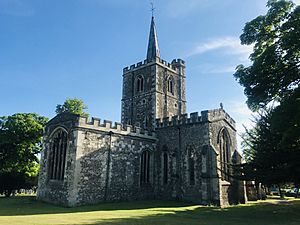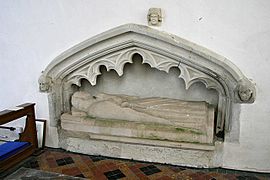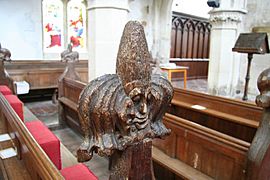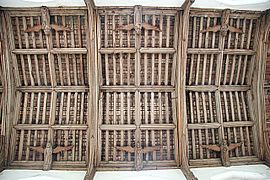St Mary the Virgin, Ivinghoe facts for kids
Quick facts for kids Church of St Mary the Virgin, Ivinghoe |
|
|---|---|

The Church St Mary the Virgin from the north-east
|
|
| Lua error in Module:Location_map at line 420: attempt to index field 'wikibase' (a nil value). | |
| Location | Church Road, Ivinghoe, Buckinghamshire, LU7 9EH |
| Country | United Kingdom |
| Denomination | Anglican |
| History | |
| Founded | c.1222 |
| Dedication | St Mary the Virgin |
| Events |
|
| Architecture | |
| Heritage designation | Grade I listed |
| Style | Early English, Decorated; some Victorian restoration work |
| Years built | c.1220 |
| Specifications | |
| Nave length | 55 feet (17 m) |
| Width | 90 feet (27 m) |
| Nave width | 19.5 feet (5.9 m) |
| Materials | Stone, flint facing with Totternhoe stone dressings |
| Administration | |
| Parish | Ivinghoe with Pitstone |
| Deanery | Mursley |
| Archdeaconry | Buckingham |
| Diocese | Oxford |
| Province | Canterbury |
The Church of St Mary the Virgin in Ivinghoe is a historic Church of England church. It's located in the village of Ivinghoe, Buckinghamshire, in the United Kingdom. This church is so important that it's a Grade I listed building, meaning it's protected for its special history and architecture. You'll find it on the main High Street, surrounded by its peaceful churchyard. It belongs to the Diocese of Oxford.
Contents
A Look Back: The Church's History
The Church of St Mary the Virgin was first built around the year 1220.
Something big happened on May 9, 1234. The church and the village were sadly burned down. This happened during a conflict involving a rebel named Richard Siward. He attacked the lands of the church's supporter, Peter des Roches, who was the Bishop of Winchester.
Exploring the Church's Architecture
The famous expert Nikolaus Pevsner once called St. Mary's a "big and noble church." It was designed in the Early English Period style around 1220. The church has a cruciform (cross-shaped) layout. It features a tower in the middle, topped with a pointy lead spire called a flèche. This kind of spire is often called a "Hertfordshire spike."
The outside walls are covered with flint stones. They also have decorative Totternhoe stone details. In the 1800s, fancy, castle-like tops called crenellations were added to the walls.
It's believed that an even older church might have stood here in the 1100s. The thickness of the west wall suggests this older building might have been made bigger to create the church we see today. After the fire in 1234, the church was rebuilt. However, some original parts still remain, like the beautiful rose windows in the transepts (the arms of the cross shape). The main parts of the church, including the chancel (the area around the altar), transepts, and nave arcades (arches in the main seating area), are from the early 1200s.
In the 1300s, the tower was rebuilt, and the aisles (side passages) were made wider. The 1400s brought even more changes and growth to the church. The walls of the nave (main seating area), chancel, and transepts were made taller. A clerestory (a row of windows high up) was added above the nave. New windows were put in, the top part of the tower was rebuilt, and a porch was added at the west entrance.
The church tower has had bells since at least 1552. Records from that time mention five bells and a smaller Sanctus bell. The bells you hear today were remade by John Warner & Sons in London in 1875.
Inside the church, the aisles are lit by windows from the Decorated Period. You can see lots of old stone carvings. There are molded doorways, round ballflower decorations, and carved leaf-like bosses (decorative knobs). The church is especially famous for its amazing 15th-century tie-beam roof. This roof is held up by stone supports with carved heads and wooden angels with wide-open wings. In the nave roof, the wooden braces have carved figures of the apostles.
In the north wall of the chancel, there's a special recessed tomb. It has a carved stone figure of a priest lying down, wearing his special clothes for celebrating Mass. The head and feet of the figure are damaged, so we don't know who it is. People have guessed it might be Peter Chaceporc (a rector from 1241–1254), Ralph de Ivinghoe (who died in 1304), or even Henry de Blois (a bishop and King Stephen's brother).
The chancel also has several old monumental brasses. These are engraved metal plates that remember people who have passed away. Some of them include Rauf Fallywolle (who died in 1349) and his wife Lucie (who died in 1368). Another remembers Richard Blackhed (who died in 1517) and his wife Maude. Several memorials show members of the large Duncombe family. They often show the person who died with smaller figures of their children. Examples include Thomas Doncombe (died 1531) and his wife Joan, William Duncombe (died 1576) and his two wives Mary and Alice, and John Douncombe (died 1594) and his wife Alyce.
In the nave, you'll find oak pews (church benches) from the 1400s or 1500s. They are known for their carved poppyhead finials (decorative tops) that sometimes have funny, grotesque faces. There is also a hexagonal, beautifully carved oak Jacobean pulpit (where sermons are given).
In 1871 and 1872, the church had a big Victorian restoration. This means it was repaired and updated by the architect George Edmund Street. He added some Victorian Gothic Revival elements, which brought back medieval styles. He also built the north and south porches and a medieval-style baptistery (where baptisms take place).
Architectural Features: A Closer Look
The Churchyard: A Place of Peace
The churchyard is the area around the church. Many of the headstones here are from the 1600s, and most of the writing on them is now hard to read. There are also five burials looked after by the Commonwealth War Graves Commission. This organization cares for the graves of people who died in the World Wars. The famous stage and film actor Athole Stewart (1879–1940) is buried here with his wife, Ellen Frances Stewart.




